| |
|||||
Revisiting the I-16 Type 29
As has been discussed elsewhere on our site, the I-16 has been the subject of much misidentification. No model, it seems, has been victimized more so than the redoubtable Type 29. This last of the I-16s, available in two primary variants, is also the subject of the next resin 1:48 release from Airwaves. Noting the very large number of requests we see on this site for this version of the I-16, we suspect that 1/48 scale modelers around the globe are set to rejoice.
Update! For a look at the pre-production test run of the Type 29 set, click here. We hope to have a Review for this set posted immediately.
In celebration of this release, and also of the I-16 itself, we thought we might revisit and update some of our older work. Indeed, so new is the proper research record of the Polikarpov fighter that much of the material on this aircraft available even on our own site is incorrect. It is, in fact, just that new. Our plan is to update and correct all of our earlier work, and we thought to start with the I-16 first of all. The older articles, until fully 'modernized', will feature placeholder artwork pointing to the updated colour profiles for the affected schemes. An example of this re-direction may be seen here. In this way, we hope that no information will be lost during the updates, and that all of the previously illustrated schemes will be repaired and completed anew.
So, allow us to both correct our own mistakes, and also to draw
modelers' attention to the last of this most important fighter family line--
the I-16 Type 29.
I-16 Type 29 "Red 16"
Pilot unknown
71 IAP VVS-KBF
ca. early 1942
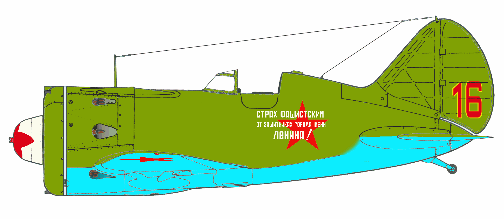
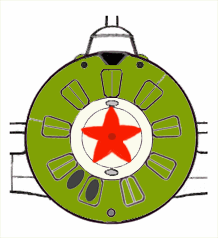
I-16 Type 29 "Red 16" was photographed in service with the Navy's
71 IAP of the Baltic Fleet, probably in the spring of 1942. The location is
not indicated on the photograph caption, but it seems to be located at the Kronshtadt
naval base. The pilot, alas, is not noted on the caption.
"16" is an attractive Type 29 of the later pattern, this characterized by the removal of the oil cooler intake on the starboard lip of the cowl, which was replaced with two oval openings in the cowl face and shutters. The aircraft seems to be wearing a factory applied scheme of quite typical appearance in AII Green (non-new shade) over AII Blue lacquers, and the upper/lower colour demarcations are quite classic for the time period.
The port side fuselage bears an inscription in white which leaves no doubt as to the location of this fighter: it reads, "Terror to Fascists from the defenders of the city named for Lenin!" The numeral on the rudder is hard to see fully, and it has been interpreted in other artwork as a "10". On balance, I believe that "16" is more likely, and even "18" is a possibility. The numeral also appears to be very thinly trimmed with a non-white colour, and while light blue has been suggested elsewhere (and is plausible), I would submit that yellow is the more likely choice. The spinner is finished in white, and bears a somewhat crudely painted star on the tip of the older 'rounded' and 'bloated' pattern, typical of those markings from the RSFSR days.
"Red 16" featured plain red star markings in four positions,
as shown. The aircraft was not particularly worn, and appeared to be in fairly
clean condition. Four RO132 rocket rails were carried under the wings.
I-16 Type 29 "Red 9"
Pilot Lt. Vershin
? IAP
autumn 1941
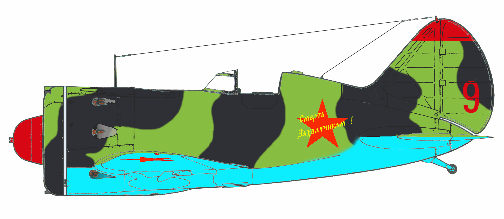
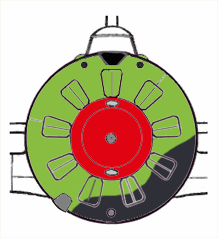
I-16 Type 29 "Red 9" was photographed in service with an unknown
regiment in Moscow (which can be identified in the photo background), probably
at Vnukovo, during the fall of 1941. The pilot is given as "Lt. Vershin"; an
officer still unidentified at the time of writing.
The time and location of the photograph tend to support the idea that this aircraft might have belonged to the 16 IAP, but for now the exact unit is not known. This machine wore a known camouflage pattern in an AII Green/Black over Blue application similar to our example, "White 75". However, as the starboard side is not seen in the photograph, I did not attempt to draw it; but the scheme's pattern should be similar to the example. The colours in this case seemed to be freshly applied, and all aspects of the finish point to a newly manufactured aircraft.
The spinner was delightfully painted in red, as was the tactical numeral on the rudder. An inscription on the port fuselage reads, "Death to Invaders", this probably in yellow and completed with an attractive 'old fashioned' type lettering. A red flash was present on the tip of the fin/rudder.
"Red 9" wore plain red star national markings in four positions,
as shown. The aircraft was an earlier pattern Type 29 with the starboard oil
cooler intake, and was photographed wearing two 'fairing type' external fuel
tanks.
I-16 Type 29 "White 1"
Pilot Szhts. Slesarchuk, Gazin, Perevera
? IAP, 7 IAK-PVO
autumn 1941
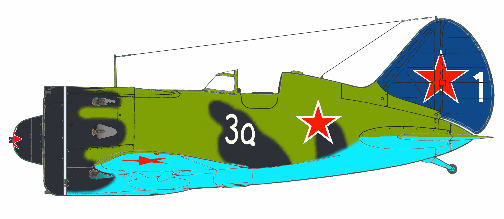
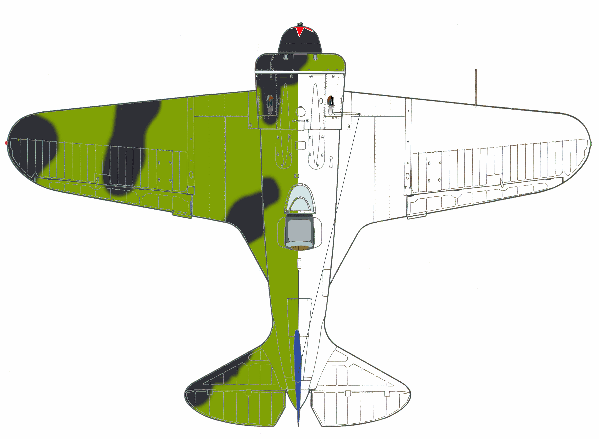
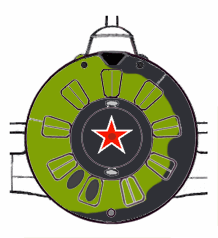
I-16 Type 29 "White 1" is famous from one of our earlier Art Deco
articles, and is here updated and corrected. A slightly better view has emerged
of this aircraft, and some new detail is available, as well. "1" was photographed
in Moscow with the PVO forces of the 7 IAK (later the 6 GIAK) during the spring
of 1942. The three pilots in front of the aircraft are Szhts. Slesarchuk,
Gazin, and Perevera, each of whom is thought to have flown this machine at various
times.
The finish looks originally to have been an AII Green single-colour scheme (uppers). This was then modified by applications of AII Black over the cowling in a meandering form that covered the exhaust ports. However, from the available photos it is clear that most of the face of the cowl remained Green. The spinner was painted Black and carried a beautifully executed star on the tip, while supplementary 'blobs' of Black colour were applied to the fuselage and wings in various shapes. A second view reveals some of the camouflage detail from the port side upper surface and the presence of a smaller white-border national star on the fuselage, but alas there is no information available on the starboard side of this aircraft.
The tactical numeral "1" on the fin is indeed finished in white. However, the fuselage markings are certainly the word "Za" (in an odd hand-written font) in Russian, and the beginning of an inscription that was obviously not completed at the time the photo was taken. The colour of the fin and rudder has been re-interpreted slightly to a darker shade of blue; other colours are still possible.
"White 1" carried national star markings in six positions, as
shown. The white borders of the fuselage and tail stars were not symmetrical,
and it is not possible to determine the type of star on the wing undersurfaces
(here show as plain red types). The aircraft was fitted with four RO132 rocket
rails, and was a later pattern Type 29 with oval cowl openings.
I-16 Type 29 "White 21"
Pilot unknown
? IAP VVS-KBF
ca. October 1942
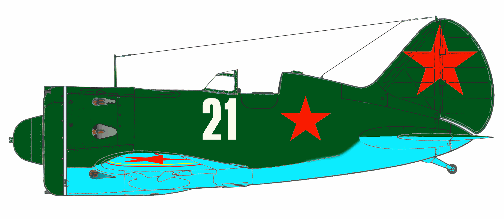
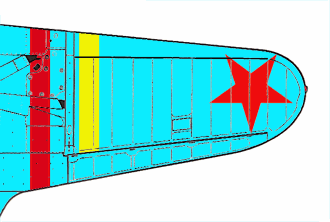
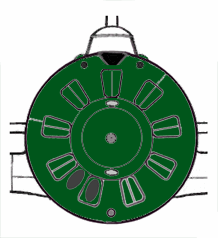
I-16 Type 29 "White 21" was photographed along the Baltic Front
during October 1942. The regiment is unrecorded, but the machine certainly looks
to be in Navy service as part of the Baltic Fleet's air forces (possibly with
the 4 GIAP). A fine published photograph of this aircraft may be found in Red
Stars Vol. 1.
What on first glance must seem to be an exceedingly typical and 'boring' Type 29 in fact, upon more detailed examination, reveals itself as one of the most extraordinary examples of VVS finish of the entire GPW era. In the first case, this aircraft seems to be finished in a rather dark shade of green. The film type is, alas, the infamous 'journalist' type, and so confirmation of the appearance is not possible to any certain degree. However, that being said, the most likely candidate here is the colour 'Factory Green'. Moreover, this aircraft shows absolutely no signs of having been repainted, and thus one is forced to conclude that this is the way it was completed at the factory during manufacture. That is quite remarkable, in that hitherto it was thought that this aerolacquer was used primarily in the pre-War era, essentially, and during the GPW only at Factory No.1, and therefore never on the later I-16 variants such as the Type 24 and -29. If this is indeed Factory Green, it means that either Factory No.21 or No.153 were using this finish virtually to the end of I-16 manufacture, and that these three aircraft (in the photo) represent the only known photograph of this practice. Remarkable, indeed....
Secondly, "21" demonstrates some very unusual markings on the wing undersurfaces. Looking to the photo, it is clear that the star national marking has been applied upside-down. Of the many thousands of photographs I have examined over the years, I have never before seen this done. Furthermore, there appear to be some entirely unprecedented stripes along the wing undersurfaces. Again, the film type leaves room for some doubt, but these markings appear to be present (but not entirely similar) on all three aircraft in view, and also on "21's" landing gear cover, and I am reluctant to believe that this could be a trick of the photography or print; these must be actual features. There look to be two stripes on "White 21", one darker than the other. I have interpreted these as red and yellow, respectively, but it is impossible to know with certainty. One wonders if this photo was not the inspiration for artists like Stankov and Kulikov, who seem determined to draw stripes like this on all VVS aircraft? In any case, I have never seen such stripes previously.
"White 21" featured plain red stars in at least four positions,
as shown. The wing upper surfaces are not visible, but stars in that location
by the time of Type 29 manufacture are quite unusual. The aircraft carried four
RO132 rocket rails under the wings, and was a later manufacture Type 29 version.
I-16 Type 29 "White 30"
Pilot Kpt. M.D. Sergeev
8 IAP VVS-ChF
ca. winter 1941-42
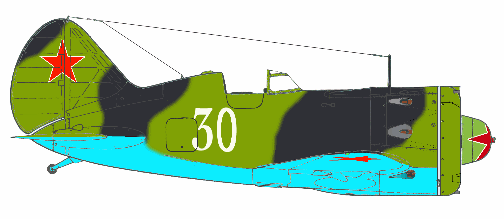
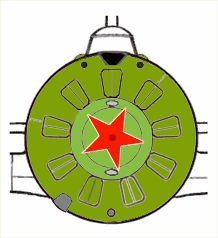
I-16 Type 29 "White 30" was the personal mount of Kapitan Mirovan
Sergeev of the 8 IAP of the Black Sea Fleet during the heroic defense of Sevastopol
during the winter of 1941-42. Sergeev was apparently of Yugoslav origin (or
birth), and joined the VVS in 1938.
"30" was finished in an AII Green and Black application over AII Blue; the green shade again being of the more worn variety. This pattern is another I-16 finish that is strongly suggested as a factory application, but alas, and frustratingly, no known views are available for the port nor upper surfaces of this camouflage.
"White 30" wore an attractive white border national star on the fin/rudder, and a similar marking expertly applied to the spinner. The spinner seems to have been a 'newer' shade of AII Green lacquer; perhaps a repainting job or even a replacement unit? The tactical number is in white, and completed in an attractive style font.
"30" wore national star markings in at least four positions,
as shown; the undersurface stars appeared to have been pain red types. The wing
upper surfaces are not visible, but stars in that location by the time of Type
29 manufacture are quite unusual. The aircraft carried four RO132 rocket rails
under the wings, and was an earlier pattern Type 29 version.
I-16 Type 29 "White 48"
Pilot Lt. Dobrolovskiy (?)
156 IAP
autumn 1941
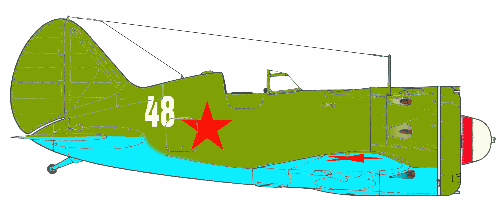
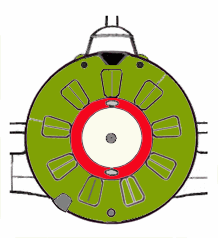
I-16 Type 29 "White 48" was photographed in service with the 156
IAP along the Leningrad Front during the fall of 1941. The pilot of this aircraft
is thought to be Igor Dobrolovskiy, one of the several 'forgotten aces' serving
with the 156 IAP during its early days in the north. A partial view of the front
of this machine has been published in Maslov's outstanding Armada title, Fighter
I-16.
"White 48" is finished in a classic AII Green/Blue application of the time, the upper surface colour demonstrating a darkened, worn shade. The tactical numeral was rendered in white in a very nice font, and placed well up on the fuselage sides. The spinner has been attractively painted with a red base, and the main section in white.
The aircraft wore plain red national star markings in four positions,
as shown. "48" was equipped with six RO82 rocket rails, and the propeller blades
appear to have been unpainted.
I-16 Type 29 "Yellow 45"
Pilot A. Pavlovskiy (?)
156 IAP
ca. Winter 1941-42
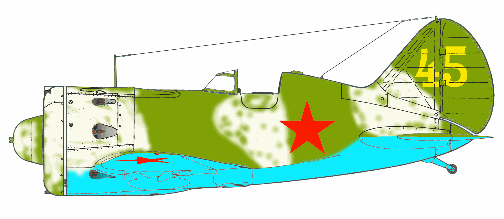
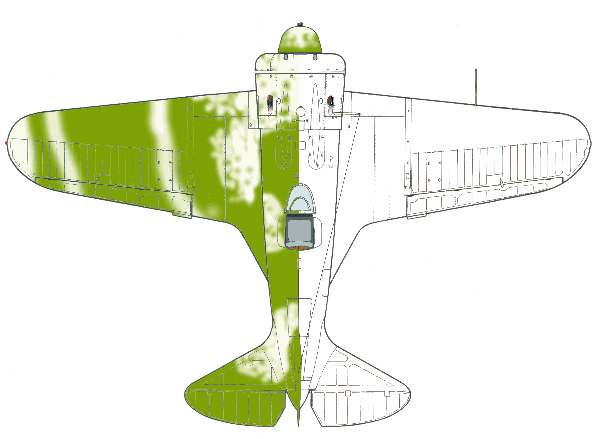
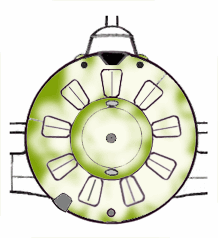
Another updated favourite from the Art Deco pages, this wonderful
Type 29 was photographed in service with the 156 IAP during the Winter of 1941-42.
The pilot of this machine is not confirmed, but the photo's caption has written
"Pavlovskovo" in the margin (meaning, belonging to Pavlovskiy), and there was
indeed a pilot by the name of A. Pavlovskiy in the Regiment at this time. This
aircraft is known from a single photograph in the collection of the Tsentralniy
Dom Aviatsia i Kosmonavtika, Moscow.
"Yellow 45" seems to have started life as a simple AII Green/Blue camouflage scheme, and subsequently was 'embellished' with applications of MK-7 white distemper in purposeful looking patterns. The application of white color over the port upper wing surface is just visible in the photograph, and is particularly pleasing. No view of the starboard side details is known.
The MK-7 finish seems to be somewhat worn, as was typical for this finish, and the machine does give the impression of significant service use over-all. Not much else is known about this aircraft, save that the stainless steel cowl band has been largely over painted on the upper surfaces with the MK-7 White application.
"Yellow 45" wore plain red star national markings in four positions,
as shown. The aircraft was an earlier pattern Type 29.